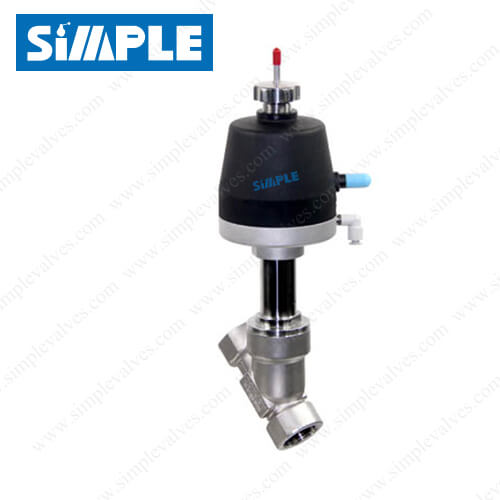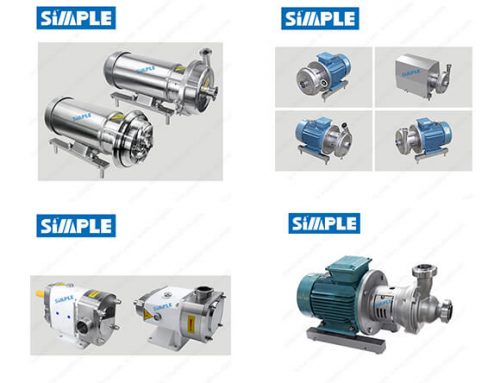An angle seat valve falls into the category of pneumatically-controlled valves. In pneumatic-controlled valves, there’s a piston or diaphragm actuator which retracts, upon receiving pressures from a pilot medium, thereby unseating a plug from the fluid pathway so that the fluid is allowed to flow.
Because the seat has been positioned at an angle such that there’s no flow restriction when opened, the valve is suitable for use with high viscous fluids. They’re also ideal for use with high-temperature media or where differential pressure is low.
They’re suitable for applications that require clean and sterile applications to control the flow of gases, steam and liquids – especially aggressive fluids. Thus it brings us to the Sanitary Angle Seat-Valve.
What Is a Sanitary Angle Seat Valve?
Angle valves are suitable for use in the biopharmaceutical industry, food processing, chemical processing, beverage, dairy and other personal care applications such as cosmetics. Specific usage areas include: as switches in automatic control systems, Industrial Compressors, Steam Applications, Printers & Paint Dispensers, Water Treatment Machines, bottling & Dispensing Machines, Washing & Laundry Machines and more.
For the various sanitary applications, the angle seat valves meet Good Manufacturing Practices (GMP) in addition to health, medical and food standards. These include clean-polished surfaces (a fineness 0.4-0.8μm), use of Non-toxic sealing (rubber or stainless steel), allowing for cleaning and disinfection in site and prevention of media entrapment.
Most sanitary angle valves feature the following very improved sealing and performance characteristics:
When getting sanitary angle seat valves for the various sterile processing applications, essential specifications to be considered include the diameter of the valve seat, body material, end connection, working temperature, and pressure.
The valve body can be 316 stainless steel, plastic or forged from brass. Pick a valve forged from steel for the long-life cycle. Typical wetting materials include CF3M or 316 ss. In terms of end connections, you can get the threaded (thread size 1/2″ -3″), clamped, flanged (tailor-made) or welded valves. For your sanitary applications, go with the tri-clamp process connection valve.
The valve can be configured for bi-directional flow or installed such that flow direction is from above or below the seat. Flow from below the seat reduces the effects of water hammer.
Angle seat valves deliver several (millions) cycles in tough applications involving aggressive media, gas, steam, and liquids. They’re designed to withstand temperature as low as -26A and as high as 400A with up to 500 psi of pressure.
In terms of flow rate, you have to determine the Kv-value your application requires plus the medium characteristics. Kv-value is the rate at which water flows when the pressure drops by 1 bar. Make use of valve sizing calculator to get the necessary flow rate and then choose the best valve size.
For the seat materials, you can get valves with FDA approved PTFE seats. The type of sealing determines the working temperature too.
Sanitary angle valves feature robust designs for an extended life cycle and smooth operations. The angle seat valve is piston operated and can feature a closure spring. The valve seat gets positioned at an angle for a restriction-less flow upon being unplugqed. A high-pressure pilot medium (compressed air, water, oil) in a cylinder is used to exert pressure on the valve actuator.
Sanitary angle seat valves feature large pistons for more output pressure. The pistons usually multiply the input force. And the large-sized pistons are suitable where the air supply is very low to generate necessary force with less input force.
Sanitary angle valves also feature improved sealing to keep off emissions and prolong the media life. The plug seats on Teflon PTFE seats and is connected to the piston on the other end. The design is such that the piston retracts further away from the valve seat to allow for maximum flow rate.
For mounting, the piston is designed with ports (either threaded or NAMUR style) for easier plugging without the use of lubricants or screws that would otherwise damage the equipment.
In terms of rotation, the piston head is designed for 360A to give the air and solenoid lines maximum position.
The compressed pilot medium is kept in the upper section of the cylinder so that enough pressure gets built up forcing the piston or diaphragm to provide the necessary motion for dislodging a plug from the fluid path. The mechanical motion created by the actuator can be linear or rotary, in angle seat valves it’s the latter.
To prevent hydraulic shock (water-hammer) upon the sudden closure of the valve modern designs feature protection mechanisms to keep the valve from propagating pressure throughout the fluid upon closing.
Water-hammer protection keeps the pipes from collapsing and prevents annoying vibrations and noise when the valve closes.
Closing can be done normally using a spring or through double-acting. In normal closing the spring compression is released, the seat returns to its position effectively sealing off the fluid path. In double-acting, the return spring is missing, so the pilot medium provides the necessary mechanism.
The pressure ranges the valve operates in depends on the pressure of the pilot medium used, the pressure of the controlled fluid, the direction of flow of the controlled fluid and construction parameters. The construction parameters could be the spring force, the diameter of the fluid path (orifice) and that of the actuator cylinder.
Why Use a Sanitary Angle Seat Valve?
Because the seat is positioned at an angle such that flow is restriction-less when open, the valve is suitable for use in applications requiring:
- Excellent flow and at a maximized rate.
- Minimum pressure drops
- Clean, sterile processes
The valves will usually double or even triple whatever amount of input force gets exerted. They’re therefore operational even when the differential pressure is close to zero as they require little pressure. The high output pressure is suitable for application in high flow pipelines and highly viscous fluids.
The linear piston action also provides for very tight shutoff that keeps off external contamination thereby maintaining the lifespan of the fluid. Also, the linear action enables fast opening and closing operations suitable for fast-acting applications.
The valves have a longer cycle life when compared to ball valves because of the robust design features. They are therefore suitable for use in harsh applications. They’re also ideal as alternatives to the solenoid-controlled valves especially with high viscous or contaminated media where the solenoid valves would otherwise underperform.
Contact Factory
As a manufacturer of stainless steel sanitary valves, SIMPLE VALVES aims to arm its potential customers with information that would help them in making an informed decision.
Our sales representatives are ready to help, please feel free to email us at sales@simplevalves.com or submit your request directly in below form.











Leave A Comment